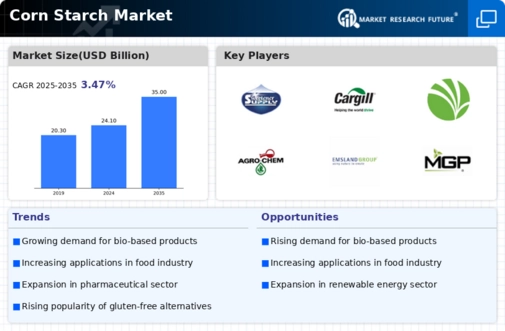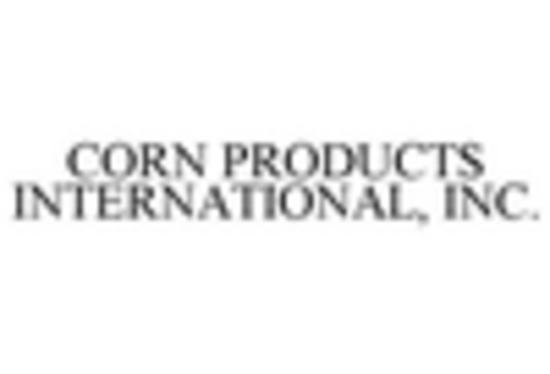Food & Beverages
Textiles
Paper & Packaging
Pharmaceuticals
Biodegradable Plastics
Native Starch
Modified Starch
Specialty Starch
Yellow Corn
White Corn
Waxy Corn
Industrial
Commercial
Residential
North America
Europe
South America
Asia Pacific
Middle East and Africa
North America Outlook (USD Billion, 2019-2035)
North America Corn Starch Market by Application Type
Food & Beverages
Textiles
Paper & Packaging
Pharmaceuticals
Biodegradable Plastics
North America Corn Starch Market by Type
Native Starch
Modified Starch
Specialty Starch
North America Corn Starch Market by Source Type
Yellow Corn
White Corn
Waxy Corn
North America Corn Starch Market by End Use Type
Industrial
Commercial
Residential
North America Corn Starch Market by Regional Type
US
Canada
US Outlook (USD Billion, 2019-2035)
US Corn Starch Market by Application Type
Food & Beverages
Textiles
Paper & Packaging
Pharmaceuticals
Biodegradable Plastics
US Corn Starch Market by Type
Native Starch
Modified Starch
Specialty Starch
US Corn Starch Market by Source Type
Yellow Corn
White Corn
Waxy Corn
US Corn Starch Market by End Use Type
Industrial
Commercial
Residential
CANADA Outlook (USD Billion, 2019-2035)
CANADA Corn Starch Market by Application Type
Food & Beverages
Textiles
Paper & Packaging
Pharmaceuticals
Biodegradable Plastics
CANADA Corn Starch Market by Type
Native Starch
Modified Starch
Specialty Starch
CANADA Corn Starch Market by Source Type
Yellow Corn
White Corn
Waxy Corn
CANADA Corn Starch Market by End Use Type
Industrial
Commercial
Residential
Europe Outlook (USD Billion, 2019-2035)
Europe Corn Starch Market by Application Type
Food & Beverages
Textiles
Paper & Packaging
Pharmaceuticals
Biodegradable Plastics
Europe Corn Starch Market by Type
Native Starch
Modified Starch
Specialty Starch
Europe Corn Starch Market by Source Type
Yellow Corn
White Corn
Waxy Corn
Europe Corn Starch Market by End Use Type
Industrial
Commercial
Residential
Europe Corn Starch Market by Regional Type
Germany
UK
France
Russia
Italy
Spain
Rest of Europe
GERMANY Outlook (USD Billion, 2019-2035)
GERMANY Corn Starch Market by Application Type
Food & Beverages
Textiles
Paper & Packaging
Pharmaceuticals
Biodegradable Plastics
GERMANY Corn Starch Market by Type
Native Starch
Modified Starch
Specialty Starch
GERMANY Corn Starch Market by Source Type
Yellow Corn
White Corn
Waxy Corn
GERMANY Corn Starch Market by End Use Type
Industrial
Commercial
Residential
UK Outlook (USD Billion, 2019-2035)
UK Corn Starch Market by Application Type
Food & Beverages
Textiles
Paper & Packaging
Pharmaceuticals
Biodegradable Plastics
UK Corn Starch Market by Type
Native Starch
Modified Starch
Specialty Starch
UK Corn Starch Market by Source Type
Yellow Corn
White Corn
Waxy Corn
UK Corn Starch Market by End Use Type
Industrial
Commercial
Residential
FRANCE Outlook (USD Billion, 2019-2035)
FRANCE Corn Starch Market by Application Type
Food & Beverages
Textiles
Paper & Packaging
Pharmaceuticals
Biodegradable Plastics
FRANCE Corn Starch Market by Type
Native Starch
Modified Starch
Specialty Starch
FRANCE Corn Starch Market by Source Type
Yellow Corn
White Corn
Waxy Corn
FRANCE Corn Starch Market by End Use Type
Industrial
Commercial
Residential
RUSSIA Outlook (USD Billion, 2019-2035)
RUSSIA Corn Starch Market by Application Type
Food & Beverages
Textiles
Paper & Packaging
Pharmaceuticals
Biodegradable Plastics
RUSSIA Corn Starch Market by Type
Native Starch
Modified Starch
Specialty Starch
RUSSIA Corn Starch Market by Source Type
Yellow Corn
White Corn
Waxy Corn
RUSSIA Corn Starch Market by End Use Type
Industrial
Commercial
Residential
ITALY Outlook (USD Billion, 2019-2035)
ITALY Corn Starch Market by Application Type
Food & Beverages
Textiles
Paper & Packaging
Pharmaceuticals
Biodegradable Plastics
ITALY Corn Starch Market by Type
Native Starch
Modified Starch
Specialty Starch
ITALY Corn Starch Market by Source Type
Yellow Corn
White Corn
Waxy Corn
ITALY Corn Starch Market by End Use Type
Industrial
Commercial
Residential
SPAIN Outlook (USD Billion, 2019-2035)
SPAIN Corn Starch Market by Application Type
Food & Beverages
Textiles
Paper & Packaging
Pharmaceuticals
Biodegradable Plastics
SPAIN Corn Starch Market by Type
Native Starch
Modified Starch
Specialty Starch
SPAIN Corn Starch Market by Source Type
Yellow Corn
White Corn
Waxy Corn
SPAIN Corn Starch Market by End Use Type
Industrial
Commercial
Residential
REST OF EUROPE Outlook (USD Billion, 2019-2035)
REST OF EUROPE Corn Starch Market by Application Type
Food & Beverages
Textiles
Paper & Packaging
Pharmaceuticals
Biodegradable Plastics
REST OF EUROPE Corn Starch Market by Type
Native Starch
Modified Starch
Specialty Starch
REST OF EUROPE Corn Starch Market by Source Type
Yellow Corn
White Corn
Waxy Corn
REST OF EUROPE Corn Starch Market by End Use Type
Industrial
Commercial
Residential
APAC Outlook (USD Billion, 2019-2035)
APAC Corn Starch Market by Application Type
Food & Beverages
Textiles
Paper & Packaging
Pharmaceuticals
Biodegradable Plastics
APAC Corn Starch Market by Type
Native Starch
Modified Starch
Specialty Starch
APAC Corn Starch Market by Source Type
Yellow Corn
White Corn
Waxy Corn
APAC Corn Starch Market by End Use Type
Industrial
Commercial
Residential
APAC Corn Starch Market by Regional Type
China
India
Japan
South Korea
Malaysia
Thailand
Indonesia
Rest of APAC
CHINA Outlook (USD Billion, 2019-2035)
CHINA Corn Starch Market by Application Type
Food & Beverages
Textiles
Paper & Packaging
Pharmaceuticals
Biodegradable Plastics
CHINA Corn Starch Market by Type
Native Starch
Modified Starch
Specialty Starch
CHINA Corn Starch Market by Source Type
Yellow Corn
White Corn
Waxy Corn
CHINA Corn Starch Market by End Use Type
Industrial
Commercial
Residential
INDIA Outlook (USD Billion, 2019-2035)
INDIA Corn Starch Market by Application Type
Food & Beverages
Textiles
Paper & Packaging
Pharmaceuticals
Biodegradable Plastics
INDIA Corn Starch Market by Type
Native Starch
Modified Starch
Specialty Starch
INDIA Corn Starch Market by Source Type
Yellow Corn
White Corn
Waxy Corn
INDIA Corn Starch Market by End Use Type
Industrial
Commercial
Residential
JAPAN Outlook (USD Billion, 2019-2035)
JAPAN Corn Starch Market by Application Type
Food & Beverages
Textiles
Paper & Packaging
Pharmaceuticals
Biodegradable Plastics
JAPAN Corn Starch Market by Type
Native Starch
Modified Starch
Specialty Starch
JAPAN Corn Starch Market by Source Type
Yellow Corn
White Corn
Waxy Corn
JAPAN Corn Starch Market by End Use Type
Industrial
Commercial
Residential
SOUTH KOREA Outlook (USD Billion, 2019-2035)
SOUTH KOREA Corn Starch Market by Application Type
Food & Beverages
Textiles
Paper & Packaging
Pharmaceuticals
Biodegradable Plastics
SOUTH KOREA Corn Starch Market by Type
Native Starch
Modified Starch
Specialty Starch
SOUTH KOREA Corn Starch Market by Source Type
Yellow Corn
White Corn
Waxy Corn
SOUTH KOREA Corn Starch Market by End Use Type
Industrial
Commercial
Residential
MALAYSIA Outlook (USD Billion, 2019-2035)
MALAYSIA Corn Starch Market by Application Type
Food & Beverages
Textiles
Paper & Packaging
Pharmaceuticals
Biodegradable Plastics
MALAYSIA Corn Starch Market by Type
Native Starch
Modified Starch
Specialty Starch
MALAYSIA Corn Starch Market by Source Type
Yellow Corn
White Corn
Waxy Corn
MALAYSIA Corn Starch Market by End Use Type
Industrial
Commercial
Residential
THAILAND Outlook (USD Billion, 2019-2035)
THAILAND Corn Starch Market by Application Type
Food & Beverages
Textiles
Paper & Packaging
Pharmaceuticals
Biodegradable Plastics
THAILAND Corn Starch Market by Type
Native Starch
Modified Starch
Specialty Starch
THAILAND Corn Starch Market by Source Type
Yellow Corn
White Corn
Waxy Corn
THAILAND Corn Starch Market by End Use Type
Industrial
Commercial
Residential
INDONESIA Outlook (USD Billion, 2019-2035)
INDONESIA Corn Starch Market by Application Type
Food & Beverages
Textiles
Paper & Packaging
Pharmaceuticals
Biodegradable Plastics
INDONESIA Corn Starch Market by Type
Native Starch
Modified Starch
Specialty Starch
INDONESIA Corn Starch Market by Source Type
Yellow Corn
White Corn
Waxy Corn
INDONESIA Corn Starch Market by End Use Type
Industrial
Commercial
Residential
REST OF APAC Outlook (USD Billion, 2019-2035)
REST OF APAC Corn Starch Market by Application Type
Food & Beverages
Textiles
Paper & Packaging
Pharmaceuticals
Biodegradable Plastics
REST OF APAC Corn Starch Market by Type
Native Starch
Modified Starch
Specialty Starch
REST OF APAC Corn Starch Market by Source Type
Yellow Corn
White Corn
Waxy Corn
REST OF APAC Corn Starch Market by End Use Type
Industrial
Commercial
Residential
South America Outlook (USD Billion, 2019-2035)
South America Corn Starch Market by Application Type
Food & Beverages
Textiles
Paper & Packaging
Pharmaceuticals
Biodegradable Plastics
South America Corn Starch Market by Type
Native Starch
Modified Starch
Specialty Starch
South America Corn Starch Market by Source Type
Yellow Corn
White Corn
Waxy Corn
South America Corn Starch Market by End Use Type
Industrial
Commercial
Residential
South America Corn Starch Market by Regional Type
Brazil
Mexico
Argentina
Rest of South America
BRAZIL Outlook (USD Billion, 2019-2035)
BRAZIL Corn Starch Market by Application Type
Food & Beverages
Textiles
Paper & Packaging
Pharmaceuticals
Biodegradable Plastics
BRAZIL Corn Starch Market by Type
Native Starch
Modified Starch
Specialty Starch
BRAZIL Corn Starch Market by Source Type
Yellow Corn
White Corn
Waxy Corn
BRAZIL Corn Starch Market by End Use Type
Industrial
Commercial
Residential
MEXICO Outlook (USD Billion, 2019-2035)
MEXICO Corn Starch Market by Application Type
Food & Beverages
Textiles
Paper & Packaging
Pharmaceuticals
Biodegradable Plastics
MEXICO Corn Starch Market by Type
Native Starch
Modified Starch
Specialty Starch
MEXICO Corn Starch Market by Source Type
Yellow Corn
White Corn
Waxy Corn
MEXICO Corn Starch Market by End Use Type
Industrial
Commercial
Residential
ARGENTINA Outlook (USD Billion, 2019-2035)
ARGENTINA Corn Starch Market by Application Type
Food & Beverages
Textiles
Paper & Packaging
Pharmaceuticals
Biodegradable Plastics
ARGENTINA Corn Starch Market by Type
Native Starch
Modified Starch
Specialty Starch
ARGENTINA Corn Starch Market by Source Type
Yellow Corn
White Corn
Waxy Corn
ARGENTINA Corn Starch Market by End Use Type
Industrial
Commercial
Residential
REST OF SOUTH AMERICA Outlook (USD Billion, 2019-2035)
REST OF SOUTH AMERICA Corn Starch Market by Application Type
Food & Beverages
Textiles
Paper & Packaging
Pharmaceuticals
Biodegradable Plastics
REST OF SOUTH AMERICA Corn Starch Market by Type
Native Starch
Modified Starch
Specialty Starch
REST OF SOUTH AMERICA Corn Starch Market by Source Type
Yellow Corn
White Corn
Waxy Corn
REST OF SOUTH AMERICA Corn Starch Market by End Use Type
Industrial
Commercial
Residential
MEA Outlook (USD Billion, 2019-2035)
MEA Corn Starch Market by Application Type
Food & Beverages
Textiles
Paper & Packaging
Pharmaceuticals
Biodegradable Plastics
MEA Corn Starch Market by Type
Native Starch
Modified Starch
Specialty Starch
MEA Corn Starch Market by Source Type
Yellow Corn
White Corn
Waxy Corn
MEA Corn Starch Market by End Use Type
Industrial
Commercial
Residential
MEA Corn Starch Market by Regional Type
GCC Countries
South Africa
Rest of MEA
GCC COUNTRIES Outlook (USD Billion, 2019-2035)
GCC COUNTRIES Corn Starch Market by Application Type
Food & Beverages
Textiles
Paper & Packaging
Pharmaceuticals
Biodegradable Plastics
GCC COUNTRIES Corn Starch Market by Type
Native Starch
Modified Starch
Specialty Starch
GCC COUNTRIES Corn Starch Market by Source Type
Yellow Corn
White Corn
Waxy Corn
GCC COUNTRIES Corn Starch Market by End Use Type
Industrial
Commercial
Residential
SOUTH AFRICA Outlook (USD Billion, 2019-2035)
SOUTH AFRICA Corn Starch Market by Application Type
Food & Beverages
Textiles
Paper & Packaging
Pharmaceuticals
Biodegradable Plastics
SOUTH AFRICA Corn Starch Market by Type
Native Starch
Modified Starch
Specialty Starch
SOUTH AFRICA Corn Starch Market by Source Type
Yellow Corn
White Corn
Waxy Corn
SOUTH AFRICA Corn Starch Market by End Use Type
Industrial
Commercial
Residential
REST OF MEA Outlook (USD Billion, 2019-2035)
REST OF MEA Corn Starch Market by Application Type
Food & Beverages
Textiles
Paper & Packaging
Pharmaceuticals
Biodegradable Plastics
REST OF MEA Corn Starch Market by Type
Native Starch
Modified Starch
Specialty Starch
REST OF MEA Corn Starch Market by Source Type
Yellow Corn
White Corn
Waxy Corn
REST OF MEA Corn Starch Market by End Use Type
Industrial
Commercial
Residential

















Leave a Comment